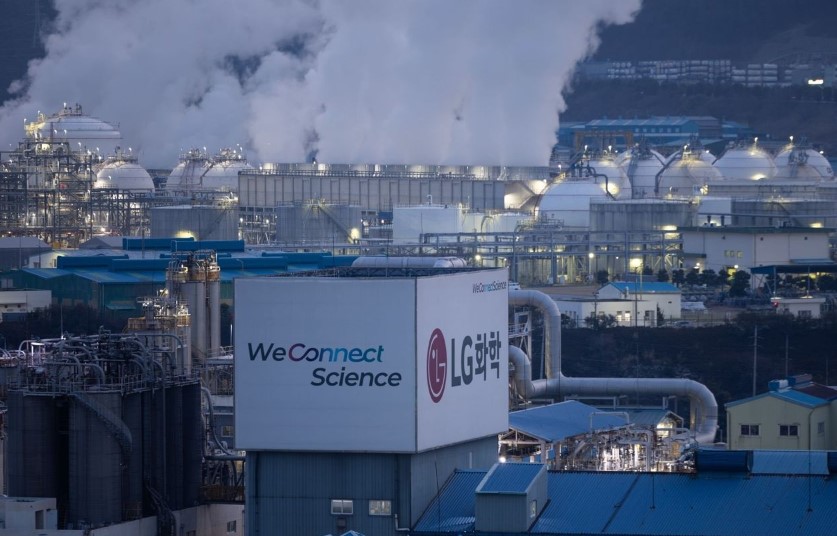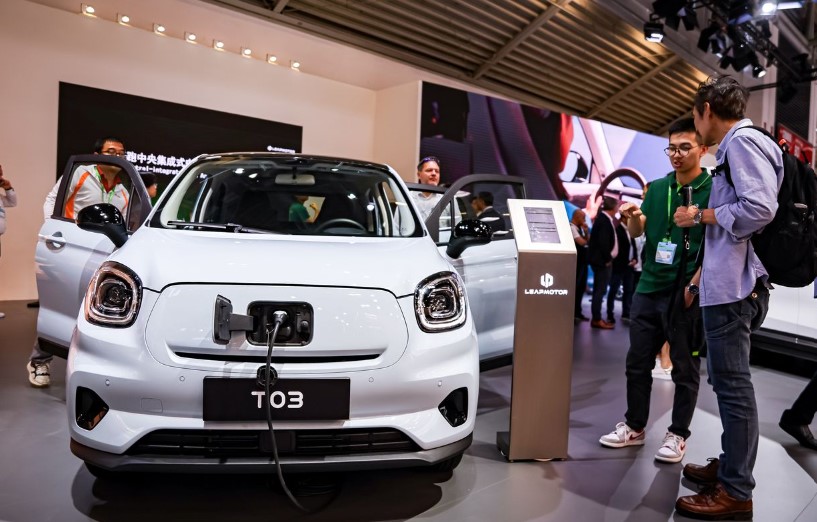 中国电池厂商制定迂回路线绕过美国制裁
中国电池厂商制定迂回路线绕过美国制裁
Chinese EV Suppliers Plan Side Doors Into U.S. Market
译文简介
对电动汽车行业至关重要的中国动力电池产业正寻求与美国的自由贸易伙伴韩国和摩洛哥达成交易,以求从美国日益增长的需求中获利,并绕过让它们无法进入该市场的规则壁垒。
正文翻译
【Chinese EV Suppliers Plan Side Doors Into U.S. Market】
【中国电池厂商制定迂回路线绕过美国制裁】
【中国电池厂商制定迂回路线绕过美国制裁】

SINGAPORE—Chinese battery companies critical to electric vehicles are pursuing deals with U.S. free-trade partners South Korea and Morocco, seeking to tap growing demand in America and bypass rules aimed at shutting them out of the market.
对电动汽车行业至关重要的中国动力电池产业正寻求与美国的自由贸易伙伴韩国和摩洛哥达成交易,以求从美国日益增长的需求中获利,并绕过让它们无法进入该市场的规则壁垒。
Chinese businesses that supply raw materials to make EV batteries have announced at least nine joint ventures and investments worth more than $4.5 billion in South Korea this year, according to a Wall Street Journal review of stock exchange filings.
根据《华尔街日报》对证券交易所公告的查阅,为制造电动汽车电池提供原材料的中国企业今年以来在韩国宣布成立了至少九家合资企业,投资总金额超过45亿美元。
根据《华尔街日报》对证券交易所公告的查阅,为制造电动汽车电池提供原材料的中国企业今年以来在韩国宣布成立了至少九家合资企业,投资总金额超过45亿美元。
At least four Chinese firms said they plan to build plants in Morocco producing battery-related products. Morocco sits on over 70% of the world’s known phosphate reserve, a raw material key to EV batteries.
至少四家中国企业表示计划在摩洛哥建厂,生产电池相关产品。摩洛哥拥有全球已知磷酸盐储量的70%以上,磷酸盐是生产电动汽车电池的关键原材料。
至少四家中国企业表示计划在摩洛哥建厂,生产电池相关产品。摩洛哥拥有全球已知磷酸盐储量的70%以上,磷酸盐是生产电动汽车电池的关键原材料。
By working out of the two countries, the Chinese suppliers hope to supply car and battery makers eligible for incentives doled out by the $430 billion Inflation Reduction Act, which rewards businesses that source materials domestically or from free-trade partners.
通过在这两个国家进行生产,这些中国供应商希望为符合《通胀削减法案》激励条件的汽车和电池制造商供货。规模4,300亿美元的《通胀削减法案》规定,从美国国内或向自由贸易伙伴国采购材料的企业可享受相关激励措施。
通过在这两个国家进行生产,这些中国供应商希望为符合《通胀削减法案》激励条件的汽车和电池制造商供货。规模4,300亿美元的《通胀削减法案》规定,从美国国内或向自由贸易伙伴国采购材料的企业可享受相关激励措施。
Over the next two years, the new law shuts out battery content and critical materials from so-called “foreign entities of concern,” a provision industry experts say is targeted at minimizing China’s involvement in America’s EV supply chain.
在接下来的两年里,这项新法律将把所谓“受关注外国实体”的电池成分和关键材料拒之门外,业内专家认为,这一规定旨在最大限度地减少中国在美国电动汽车供应链中的参与。
在接下来的两年里,这项新法律将把所谓“受关注外国实体”的电池成分和关键材料拒之门外,业内专家认为,这一规定旨在最大限度地减少中国在美国电动汽车供应链中的参与。
Analysts say Chinese suppliers hope such joint ventures will allow customers to continue sourcing from them and still access incentives, which offsets more than one-tenth the cost of an average EV.
分析人士表示,中国供应商希望通过成立此类合资企业,可以使客户在继续从它们那里采购的同时仍能获得激励;相关激励措施可抵消一辆普通电动汽车逾十分之一的成本。
分析人士表示,中国供应商希望通过成立此类合资企业,可以使客户在继续从它们那里采购的同时仍能获得激励;相关激励措施可抵消一辆普通电动汽车逾十分之一的成本。
“The Chinese don’t have much choice,” said Johan Bracht, a McKinsey analyst.
“中国企业没有太多选择,”麦肯锡分析师Johan Bracht说。
“中国企业没有太多选择,”麦肯锡分析师Johan Bracht说。
An executive at Shenzhen, China-based GEM said its partnership with a South Korean firm would help the raw material refiner meet IRA conditions and help the firm tap demand for EVs globally.
总部位于中国深圳的格林美股份有限公司一位高管表示,与韩国公司合作将有助于这家原材料精炼商满足《通胀削减法案》的条件,并帮助该公司受益于全球对电动汽车的需求。
总部位于中国深圳的格林美股份有限公司一位高管表示,与韩国公司合作将有助于这家原材料精炼商满足《通胀削减法案》的条件,并帮助该公司受益于全球对电动汽车的需求。
“We won’t give up on the U.S. market,” said Pan Hua, deputy general manager at GEM. “The U.S. can’t completely shut out Chinese suppliers from its market either, as much of the upstream supply chain is concentrated in China.”
格林美副总经理潘骅称,该公司不会放弃美国市场。他表示,美国不可能完全放弃涉及中国的产业链,因为产业链的集中度太高。
格林美副总经理潘骅称,该公司不会放弃美国市场。他表示,美国不可能完全放弃涉及中国的产业链,因为产业链的集中度太高。
GEM said in March that it would collectively invest up to $900 million with South Korean companies SK On and EcoPro Materials to build a precursor plant in South Korea by the end of 2024.
格林美3月份表示,将与韩国公司SK On和EcoPro Materials共同投资不超过9亿美元,最迟2024年年底在韩国建设一家前驱体工厂。
格林美3月份表示,将与韩国公司SK On和EcoPro Materials共同投资不超过9亿美元,最迟2024年年底在韩国建设一家前驱体工厂。
SK On, an EV battery maker whose partners include Ford and Hyundai, has two factories in the U.S. and plans to build four more.
SK On在美国有两家工厂,并计划再建四家。该公司是一家电动汽车动力电池制造商,合作伙伴包括福特汽车和现代汽车。
SK On在美国有两家工厂,并计划再建四家。该公司是一家电动汽车动力电池制造商,合作伙伴包括福特汽车和现代汽车。
South Korea EV suppliers benefit from partnering with Chinese firms to access key materials and expertise in processing, industry experts say.
行业专家表示,通过与中国企业合作,韩国电动汽车供应商可以获得关键材料以及加工方面的专业知识。
行业专家表示,通过与中国企业合作,韩国电动汽车供应商可以获得关键材料以及加工方面的专业知识。
Other Chinese suppliers mention in public statements their Korean joint ventures would help them expand internationally, with several listing the U.S. and Europe as target markets.
其他中国供应商在公开声明中提到,它们的韩国合资企业将助其拓展国际市场,其中几家企业的目标市场是美国和欧洲。
其他中国供应商在公开声明中提到,它们的韩国合资企业将助其拓展国际市场,其中几家企业的目标市场是美国和欧洲。
Chinese battery companies have long eyed expansion in the U.S., the world’s second-largest auto market behind China, and the money offered by the IRA accelerated their timeline of doing business there. At the same time, intense competition and overcapacity challenges in China are also driving firms to seek opportunities overseas.
中国电池企业长期以来一直着眼于在美国的扩张,《通胀削减法案》提供的资金加快了它们在美国开展业务的时间表。与此同时,中国国内激烈的竞争和产能过剩的挑战也促使企业纷纷转向海外寻求机会。美国是仅次于中国的全球第二大汽车市场。
中国电池企业长期以来一直着眼于在美国的扩张,《通胀削减法案》提供的资金加快了它们在美国开展业务的时间表。与此同时,中国国内激烈的竞争和产能过剩的挑战也促使企业纷纷转向海外寻求机会。美国是仅次于中国的全球第二大汽车市场。
Analysts say one wild card is that U.S. authorities haven’t defined what constitutes a “foreign entity of concern” in the IRA. The U.S. hasn’t defined what level of Chinese involvement and at what stage of the supply chain is acceptable for auto and battery producers to qualify for tax credits, they say.
分析师说,一个不确定因素是,美国政府尚未界定什么是《通胀削减法案》中“受关注外国实体”。他们说,美国还未明确界定,汽车和电池生产商要想有资格获得税收抵免,中国何种参与程度以及在供应链的哪个阶段是可以接受的。
分析师说,一个不确定因素是,美国政府尚未界定什么是《通胀削减法案》中“受关注外国实体”。他们说,美国还未明确界定,汽车和电池生产商要想有资格获得税收抵免,中国何种参与程度以及在供应链的哪个阶段是可以接受的。
This uncertainty means there is a risk that such joint ventures could ultimately be barred from receiving incentives, said Chris Berry, founder of energy metals consulting firm House Mountain Partners. “How involved China can be with different parts of the supply chain is an open question,” Berry said.
能源金属咨询公司House Mountain Partners的创始人Chris Berry说,这种不确定性意味着这类合资企业最终有可能被禁止享受政府的激励措施。“中国能在多大程度上参与供应链的各个环节,这个问题尚无定论,”Berry说。
能源金属咨询公司House Mountain Partners的创始人Chris Berry说,这种不确定性意味着这类合资企业最终有可能被禁止享受政府的激励措施。“中国能在多大程度上参与供应链的各个环节,这个问题尚无定论,”Berry说。
China’s role as indirect beneficiary of the IRA has come under scrutiny by American politicians.
美国政界人士已经盯上中国间接受益于《通胀削减法案》的情况。
美国政界人士已经盯上中国间接受益于《通胀削减法案》的情况。
Ford last month put on hold a $3.5 billion plant making EV batteries with Chinese battery giant Contemporary Amperex Technology Co., or CATL, in Michigan. The move followed months of pressure from key lawmakers in Washington about its Chinese partner.
福特上月搁置了与中国电池巨头宁德时代新能源科技股份有限公司在密歇根州建造规模35亿美元的电动车电池制造厂的计划;此前数月,华盛顿一些重量级议员一直在就福特的中国合作伙伴向福特施加压力。
福特上月搁置了与中国电池巨头宁德时代新能源科技股份有限公司在密歇根州建造规模35亿美元的电动车电池制造厂的计划;此前数月,华盛顿一些重量级议员一直在就福特的中国合作伙伴向福特施加压力。
Ford said it was pausing work there until the company was confident about operating the plant competitively.
福特表示,在公司有信心以具有竞争力的方式运营该工厂之前,将暂停在那里的工作。
原创翻译:龙腾网 https://www.ltaaa.cn 转载请注明出处
福特表示,在公司有信心以具有竞争力的方式运营该工厂之前,将暂停在那里的工作。
原创翻译:龙腾网 https://www.ltaaa.cn 转载请注明出处
China’s supply chain chokehold
中国扼住供应链的咽喉
中国扼住供应链的咽喉
Chinese companies are the world’s biggest producers of the four key components needed in EV battery production—cathodes, anodes, electrolytes and separators, according to industry analyst SNE Research.
据产业分析公司SNE Research,就电动汽车电池生产所需的四个关键部件——阴极、阳极、电解质和隔膜而言,中国公司是世界上最大的的生产商。
据产业分析公司SNE Research,就电动汽车电池生产所需的四个关键部件——阴极、阳极、电解质和隔膜而言,中国公司是世界上最大的的生产商。
The country has a chokehold over much of the capacity needed to refine metals such as lithium, cobalt and manganese to make them suitable for battery production, said Lukasz Bednarski, a research analyst at S&P Global.
标普全球的研究分析师Lukasz Bednarski说,中国掌握着精炼锂、钴和锰等金属所需的大部分产能;这些金属精炼后可用于电池生产。
标普全球的研究分析师Lukasz Bednarski说,中国掌握着精炼锂、钴和锰等金属所需的大部分产能;这些金属精炼后可用于电池生产。
As a result, it is difficult for the U.S. and Europe to build an independent EV battery supply chain without China’s help, at least in the near term, Bednarski added.
因此,Bednarski补充道,没有中国的帮助,美国和欧洲很难建立独立的电动汽车电池供应链,至少在短期内是这样。
因此,Bednarski补充道,没有中国的帮助,美国和欧洲很难建立独立的电动汽车电池供应链,至少在短期内是这样。
Three of the largest battery materials suppliers in China—GEM, Huayou Cobalt and CNGR Advanced Materials—have been the most active signing such cross-border deals, citing growing global investment restrictions against China as reasons for cooperation.
中国最大的三家电池材料供应商——格林美、华友钴业和中伟股份一直是最积极达成此类跨境交易的企业,它们给出的合作理由是,全球对中国的投资限制越来越多。
中国最大的三家电池材料供应商——格林美、华友钴业和中伟股份一直是最积极达成此类跨境交易的企业,它们给出的合作理由是,全球对中国的投资限制越来越多。
Many of the newly formed Chinese partnerships with South Korean and Moroccan firms produce precursors, a mix of metals required for making cathodes, a key component of batteries. Batteries are the most expensive component of an EV, accounting for about 40% of the cost of the car.
中国企业与韩国及摩洛哥企业新建立的许多合资公司生产前驱体。前驱体是一种金属混合物,生产电池关键部件阴极需要使用。电池是电动汽车最昂贵的部件,约占整车成本的40%。
中国企业与韩国及摩洛哥企业新建立的许多合资公司生产前驱体。前驱体是一种金属混合物,生产电池关键部件阴极需要使用。电池是电动汽车最昂贵的部件,约占整车成本的40%。
Zhejiang, China-based Huayou Cobalt has formed partnerships with the battery subsidiary of South Korean business titans Posco Holdings and LG Chem to build plants in South Korea this year, while Guizhou-based CNGR joined with Posco and its subsidiary to invest $1.13 billion to build two factories in the nation.
总部位于中国浙江的华友钴业已与Posco Holdings和LG化学这两家韩国商业巨头的电池子公司建立了合作关系,今年在韩国建厂,而总部位于贵州的中伟股份与Posco及其子公司联手,投资11.3亿美元在韩国建设两家工厂。
总部位于中国浙江的华友钴业已与Posco Holdings和LG化学这两家韩国商业巨头的电池子公司建立了合作关系,今年在韩国建厂,而总部位于贵州的中伟股份与Posco及其子公司联手,投资11.3亿美元在韩国建设两家工厂。
In Morocco, LG Chem last month said it would join with Huayou Cobalt and its parent company to build lithium refining and cathode materials plants, joining CNGR and Chinese lithium producer Sichuan Yahua Industrial, which have partnerships there to produce materials for EV batteries.
在摩洛哥,LG化学上月表示将与华友钴业及其母公司合作建设锂精炼和阴极材料工厂,加入中伟股份和中国锂生产商四川雅化实业集团股份有限公司的行列,后两家公司在摩洛哥都有合作企业,生产电动汽车电池所需的材料。
在摩洛哥,LG化学上月表示将与华友钴业及其母公司合作建设锂精炼和阴极材料工厂,加入中伟股份和中国锂生产商四川雅化实业集团股份有限公司的行列,后两家公司在摩洛哥都有合作企业,生产电动汽车电池所需的材料。
Huayou Cobalt, Sichuan Yahua, LG Chem and Posco didn’t respond to requests for comment. CNGR reiterated a public statement that the deal will help the company’s global expansion.
华友钴业、雅化集团、LG化学和Posco没有回应置评请求。中伟股份重申了一项公开声明,称上述交易将有助于公司进一步完善海外布局,推进全球化战略。
原创翻译:龙腾网 https://www.ltaaa.cn 转载请注明出处
华友钴业、雅化集团、LG化学和Posco没有回应置评请求。中伟股份重申了一项公开声明,称上述交易将有助于公司进一步完善海外布局,推进全球化战略。
原创翻译:龙腾网 https://www.ltaaa.cn 转载请注明出处
Chinese and South Korean companies are bracing for the possibility that these joint ventures wouldn’t be deemed as IRA-compliant.
这些合资企业可能被认为不符合《通胀削减法案》的激励条件,中韩两国公司都在为这种可能性做准备。
这些合资企业可能被认为不符合《通胀削减法案》的激励条件,中韩两国公司都在为这种可能性做准备。
Posco Future M, the Posco subsidiary with Chinese partnerships, has said the company will modify their joint venture agreements to reduce the stake of Chinese partners, should their partnership fall short of IRA requirements. The company said it is also sourcing raw material from countries such as Indonesia, the Philippines and Australia to move away from the influence of China.
与中方建立了合作关系的Posco子公司Posco Future M表示,如果与中方的合作不符合《通胀削减法案》的要求,公司将修改合资协议,减少中方合作伙伴的股权。该公司称,它还在从印尼、菲律宾和澳大利亚等国采购原材料,以摆脱中国的影响。
与中方建立了合作关系的Posco子公司Posco Future M表示,如果与中方的合作不符合《通胀削减法案》的要求,公司将修改合资协议,减少中方合作伙伴的股权。该公司称,它还在从印尼、菲律宾和澳大利亚等国采购原材料,以摆脱中国的影响。
CNGR said in a stock exchange statement that the firm and its partner may sell shares in the venture, in the event of a major change of laws and policies. GEM’s Pan said the company is preparing for unfavorable rule changes by avoiding majority ownership in any joint venture in South Korea.
中伟股份在一份证券交易所公告中表示,如果法律和政策发生重大变化,该公司及其合作伙伴可能会出售合资企业的股份。格林美的潘骅称,该公司正在为不利的规则变化做准备,其中的举措包括避免在韩国合资企业中拥有多数股权。
中伟股份在一份证券交易所公告中表示,如果法律和政策发生重大变化,该公司及其合作伙伴可能会出售合资企业的股份。格林美的潘骅称,该公司正在为不利的规则变化做准备,其中的举措包括避免在韩国合资企业中拥有多数股权。
“When we develop production bases, we will bring in overseas partners to lower our risk,” he said. “Still, if anyone plans to completely disentangle itself from the China supply chain now, it’s just not possible.”
他说,在海外基地的建设中,我们会引入海外合作伙伴以降低风险;不过,如果有人打算完全摆脱中国供应链,目前显然是不现实的。
【Stellantis押宝中国电动车初创企业】
他说,在海外基地的建设中,我们会引入海外合作伙伴以降低风险;不过,如果有人打算完全摆脱中国供应链,目前显然是不现实的。
【Stellantis押宝中国电动车初创企业】

Buying into a Chinese automaker sounds like a great answer to the challenge of making cheaper electric vehicles. If only it were easier to pick winners.
收购一家中国汽车制造商,听起来似乎是应对制造廉价电动汽车这一挑战的绝佳答案。如果能不费吹灰之力地选出赢家就好了。
Chrysler owner Stellantis said Thursday that it was spending the equivalent of about $1.6 billion to buy a roughly 20% stake in Zhejiang Leapmotor Technology. It will get two board seats and become Leapmotor’s exclusive export partner via a Europe-based joint venture in which Stellantis will own 51%.
克莱斯勒所有者Stellantis周四表示,将斥资约16亿美元收购浙江零跑科技股份有限公司20%的股份。该公司将获得两个董事会席位,并通过一家总部位于欧洲的合资企业成为零跑科技的独家出口合作伙伴,Stellantis将持有该合资企业51%的股份。
原创翻译:龙腾网 https://www.ltaaa.cn 转载请注明出处
克莱斯勒所有者Stellantis周四表示,将斥资约16亿美元收购浙江零跑科技股份有限公司20%的股份。该公司将获得两个董事会席位,并通过一家总部位于欧洲的合资企业成为零跑科技的独家出口合作伙伴,Stellantis将持有该合资企业51%的股份。
原创翻译:龙腾网 https://www.ltaaa.cn 转载请注明出处
The deal will draw comparisons with Volkswagen’s $700 million investment in Xpeng, another Chinese EV maker, in July. Both can be interpreted as admissions that Western car manufacturers need Chinese EV technology, just as Chinese ones once needed Western gasoline-engine tech.
这笔交易将被拿来与大众汽车7月份对另一家中国电动汽车制造商小鹏汽车的7亿美元投资作比较。这两宗交易都可以被解读为西方汽车制造商已经承认需要中国的电动汽车技术,就像中国汽车制造商曾经需要西方汽油发动机技术一样。
这笔交易将被拿来与大众汽车7月份对另一家中国电动汽车制造商小鹏汽车的7亿美元投资作比较。这两宗交易都可以被解读为西方汽车制造商已经承认需要中国的电动汽车技术,就像中国汽车制造商曾经需要西方汽油发动机技术一样。
But whereas Volkswagen and Xpeng are cooperating on developing VW-badged vehicles for the Chinese market, Stellantis and Leapmotor are teaming up to sell Leapmotor models outside of China. VW is worried about its falling share of the Chinese market, which it led until earlier this year. Stellantis, which had all but left China after falling out with a previous JV partner, is worried about its market share elsewhere.
不过相比之下,大众汽车和小鹏汽车正合作为中国市场开发大众汽车品牌的汽车,Stellantis和零跑科技则正携手在中国以外销售零跑汽车的车型。大众汽车对其在中国市场份额的下降感到担忧,直到今年早些时候该公司还在中国市场处于领先地位。Stellantis的心头之患则是自己在中国以外其他市场的份额,在与之前的合资伙伴决裂后该公司几乎退出了中国市场。
不过相比之下,大众汽车和小鹏汽车正合作为中国市场开发大众汽车品牌的汽车,Stellantis和零跑科技则正携手在中国以外销售零跑汽车的车型。大众汽车对其在中国市场份额的下降感到担忧,直到今年早些时候该公司还在中国市场处于领先地位。Stellantis的心头之患则是自己在中国以外其他市场的份额,在与之前的合资伙伴决裂后该公司几乎退出了中国市场。
Chinese companies can produce EVs 30% more cheaply than Western ones, according to Stellantis’s research. As the Chinese players start to export more aggressively, that cost difference will become an existential problem for global players such as Stellantis, Toyota and Volkswagen. “I am putting in my portfolio a Chinese carmaker that can compete against the Chinese competitors,” said Chief Executive Carlos Tavares on a call with analysts.
根据Stellantis的研究,中国公司生产电动汽车的成本可以比西方公司低30%。随着中国企业开始更积极地出口,这种成本差异将成为Stellantis、丰田和大众等全球企业攸关存亡的一个问题。首席执行官唐唯实在与分析师的电话会议上表示:“我将投资一家能够与中国竞争对手竞争的中国汽车制造商。”
根据Stellantis的研究,中国公司生产电动汽车的成本可以比西方公司低30%。随着中国企业开始更积极地出口,这种成本差异将成为Stellantis、丰田和大众等全球企业攸关存亡的一个问题。首席执行官唐唯实在与分析师的电话会议上表示:“我将投资一家能够与中国竞争对手竞争的中国汽车制造商。”
With the exception of Volvo-owner Geely, Chinese automakers don’t have ambitions in the U.S., given the tensions between Washington and Beijing. In Europe, too, they might find roadblocks: European Commission President Ursula von der Leyen in September launched an antisubsidy inquiry into low-cost Chinese EVs, following much lobbying by Tavares himself. But Stellantis, which also owns cheaper brands such as Fiat, will still face competition in the emerging markets that it calls its “third engine.” Fiat is the market leader in Brazil and Turkey as well as its native Italy.
鉴于美中之间的紧张关系,除了沃尔沃的所有者吉利之外,中国汽车制造商对美国市场都没什么野心。在欧洲,他们也可能会遇到障碍:欧盟委员会主席冯德莱恩于今年9月启动了对中国低成本电动汽车的反补贴调查,此前唐唯实本人进行了大量游说。但Stellantis也拥有菲亚特等价格较低的品牌,在被其称为“第三引擎”的新兴市场仍将面临竞争。菲亚特在巴西、土耳其及其本土意大利都是市场领先者。
鉴于美中之间的紧张关系,除了沃尔沃的所有者吉利之外,中国汽车制造商对美国市场都没什么野心。在欧洲,他们也可能会遇到障碍:欧盟委员会主席冯德莱恩于今年9月启动了对中国低成本电动汽车的反补贴调查,此前唐唯实本人进行了大量游说。但Stellantis也拥有菲亚特等价格较低的品牌,在被其称为“第三引擎”的新兴市场仍将面临竞争。菲亚特在巴西、土耳其及其本土意大利都是市场领先者。
Tavares said another advantage of the deal was to get a better real-time measure of China’s cost competitiveness, which he called “a powerful tool.” The implication is that Stellantis can use a better understanding of Leapmotor’s EV cost structure to target the areas where it lags behind.
唐唯实称,这笔交易的另一个好处是可以更好地实时衡量中国的成本竞争力,他称之为“一个强有力的工具”。这意味着Stellantis可以通过更好地了解零跑汽车的电动汽车成本结构,瞄准其落后的领域。
唐唯实称,这笔交易的另一个好处是可以更好地实时衡量中国的成本竞争力,他称之为“一个强有力的工具”。这意味着Stellantis可以通过更好地了解零跑汽车的电动汽车成本结构,瞄准其落后的领域。
It seems a natural evolution for the company, which was formed through a series of big deals and has made huge margin gains by benchmarking acquired businesses against each other. The old Chrysler business, which makes RAM pickup trucks and Jeep sport-utility vehicles, is now Detroit’s most profitable automaker.
对于Stellantis来说,这似乎是一次自然进化,毕竟之前这家公司就是通过一系列大规模并购组建起来的,并通过将收购的业务相互借鉴赚取了巨额利润。其原有的克莱斯勒业务生产RAM皮卡和Jeep品牌SUV,现在是底特律最赚钱的车企。
对于Stellantis来说,这似乎是一次自然进化,毕竟之前这家公司就是通过一系列大规模并购组建起来的,并通过将收购的业务相互借鉴赚取了巨额利润。其原有的克莱斯勒业务生产RAM皮卡和Jeep品牌SUV,现在是底特律最赚钱的车企。
The big risk is that Leapmotor isn’t actually the next BYD, as Stellantis appears to hope. In the first nine months of the year, the Hong Kong-listed company wasn’t even one of China’s top 10 EV brands, according to data collated by Bernstein, though it is growing fast. The Chinese EV market has been tough this year, not least because of Tesla’s price cuts, and many expect a shakeout. Leapmotor is expected to burn through $760 million this year, which is presumably one reason it is happy to take Stellantis’s money.
但其中一大风险在于,Stellantis似乎寄希望于零跑汽车成为下一个比亚迪,但实际并非如此。根据Bernstein整理的数据,尽管增长迅速,但今年前九个月,这家香港上市公司甚至不在中国前十大电动汽车品牌之列。今年中国电动汽车市场境况艰难,原因不仅仅有特斯拉的降价,而且许多人预计市场将进行洗牌。预计零跑汽车今年将烧掉7.6亿美元,这大概也是它乐于接受Stellantis投资的一个原因。
但其中一大风险在于,Stellantis似乎寄希望于零跑汽车成为下一个比亚迪,但实际并非如此。根据Bernstein整理的数据,尽管增长迅速,但今年前九个月,这家香港上市公司甚至不在中国前十大电动汽车品牌之列。今年中国电动汽车市场境况艰难,原因不仅仅有特斯拉的降价,而且许多人预计市场将进行洗牌。预计零跑汽车今年将烧掉7.6亿美元,这大概也是它乐于接受Stellantis投资的一个原因。
Market leader BYD aside, guessing which Chinese EV startups will come out on top seems a high-risk game. It is a measure of the challenge facing global automakers that Stellantis feels the need to play it.
撇开市场领头羊比亚迪不谈,下注哪家中国电动车初创企业将脱颖而出似乎风险很大。但Stellantis仍认为有必要冒这个险,这也表明了全球汽车制造商面临的挑战有多严峻。
撇开市场领头羊比亚迪不谈,下注哪家中国电动车初创企业将脱颖而出似乎风险很大。但Stellantis仍认为有必要冒这个险,这也表明了全球汽车制造商面临的挑战有多严峻。
评论翻译
很赞 ( 12 )
收藏